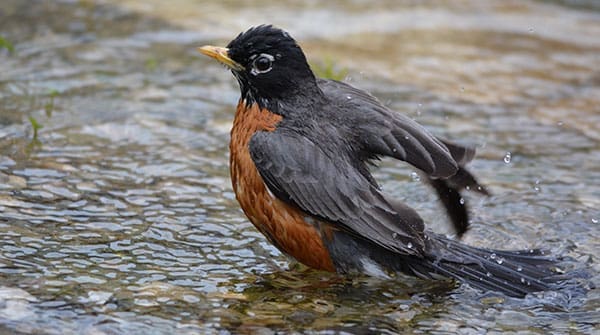Signs of spring include tiny invertebrates emerging and birds tuning up for the new season

Robin
 As the days are getting longer and warmer, I thought I’d share some clues that spring isn’t far off.
As the days are getting longer and warmer, I thought I’d share some clues that spring isn’t far off.
Many invertebrates are actually very active right now – albeit they are pretty tiny and, therefore, hard to see. Springtails are perhaps the most common invertebrate we find at this time of year. These almost microscopic “snow fleas” emerge early and provide needed protein for many animals.
Robins have been in the news recently, with thousands of them staying in Ontario this winter. But don’t they migrate? Well, some do and many don’t. Essentially, most birds can survive very inclement weather as long as they have food and cover.
In our area, food is abundant this winter. Natural berries such as buckthorn, cranberry, and mountain ash are supplemented by sumac and other seed – and fruit-bearing plants. I was most intrigued to see Robins working a small wet area at the back of my property, flipping leaves and clearly finding insect prey. I didn’t want to disturb them, so the identity of the prey remains a mystery.
 Snowy Owl |
| Related Stories |
| Isn’t it too early for birds to be nesting?
|
| Tips for setting up your bird feeders
|
| The remarkable comeback of Wild Turkeys in Ontario
|
The other morning, Cardinals started to sing, which is always welcome as it signals a new beginning for a new breeding season. It’s not that Cardinals will breed yet, but as their hormonal levels rise, they start the process of claiming and defending territories early and choosing a mate. Nuthatches and Chickadees are also practising their spring songs.
Birds such as Great Horned Owls are already nesting, and Ravens are clearly re-establishing strong pair bonds, for they, too, will breed shortly. Further north, Canada Jays will be on eggs soon, and assuredly, their young will have to be tough to survive the next few weeks in their frosty nest!
The squirrels seem a bit perkier lately, and there is a lot of chasing going on. Soon, they will mate and start their new broods in the comfort of their underground den or drey (leafy tree nest), depending on the species.
What fascinates me most is that migration starts in January as Red-tailed Hawks move north to reoccupy last summer’s territories. It is a slow process that will take weeks, but watch, and you will soon start to see more Red-tails. If you look closely, you will often notice that two birds sit near each other. Rest assured, they will be paired this breeding season.
Ducks won’t leave the Great Lakes and other inland bodies of water yet, but watch how quickly they will show up if open water becomes available further north. Horned larks, Snow Buntings and, if we’re lucky, Lapland Longspurs start to migrate in late January and early February as conditions permit. Fields where manure is spread will provide them with essential food. Saw-whet Owls will soon be on the move as well, and generally, about the last week of February, the first ones arrive and start to “sing.” Some will stay, but many will move further north to breed.
One exciting event may be about to unfold: look for an influx of owls into southern Canada. Prey species such as voles, mice and lemmings are becoming scarcer in the north and the owls that depend on them may be running out of food. If they do, the owls will migrate south in significant numbers. The first Snowy Owl showed up this week in my neighbourhood, indicating that at least one bird was prone to wandering southward.
There’s lots more happening out there right now, so hopefully, this little eye-opener will encourage you to get out in the field and see what’s happening.
Geoff Carpentier is a published author, expedition guide and environmental consultant.
For interview requests, click here.
The opinions expressed by our columnists and contributors are theirs alone and do not inherently or expressly reflect the views of our publication.
© Troy Media
Troy Media is an editorial content provider to media outlets and its own hosted community news outlets across Canada.

